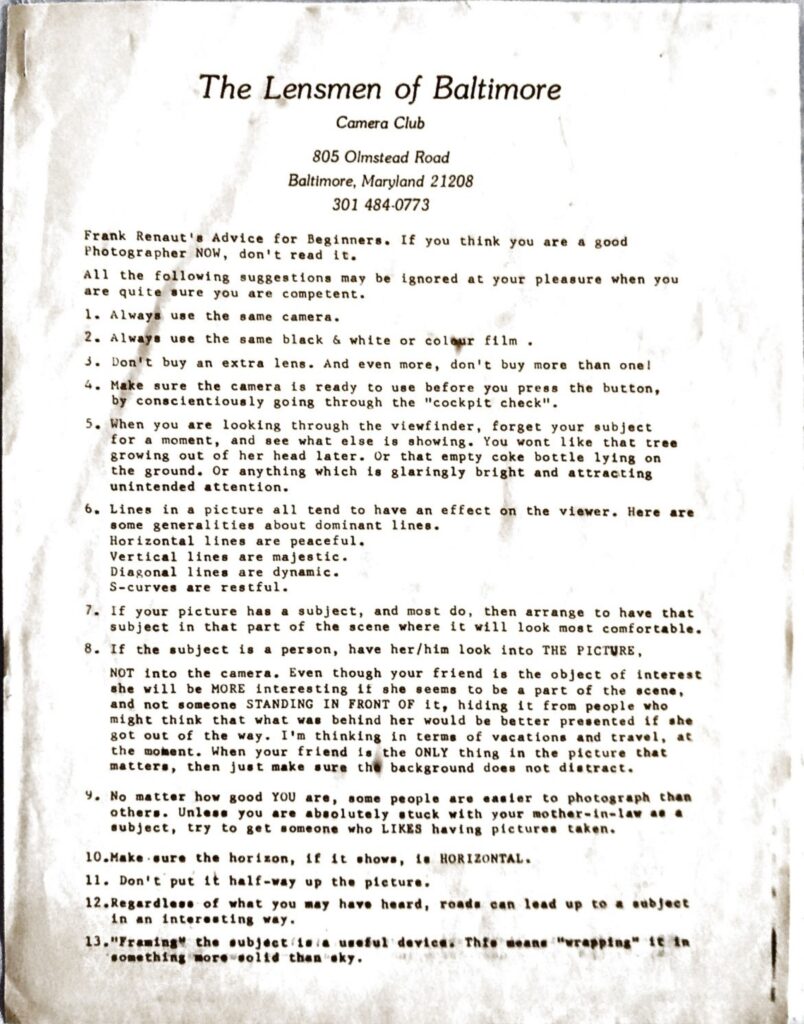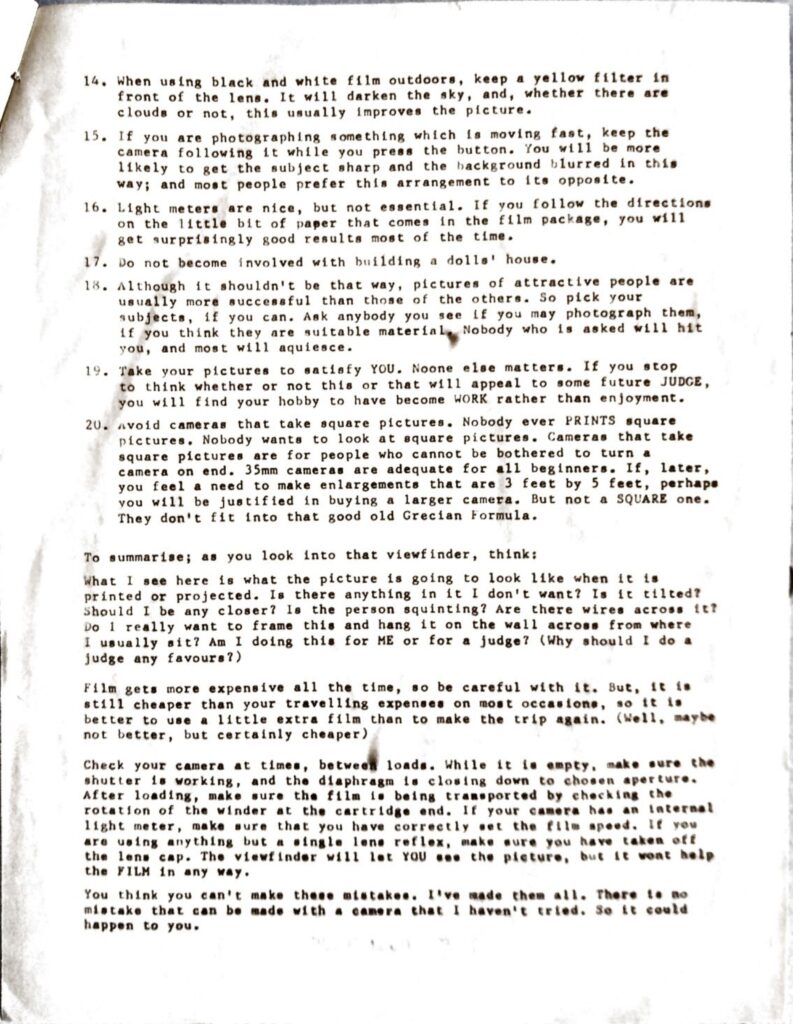The following is a scan, then transcription, of Frank Renaut’s [photography] advice for beginners. Likely written in the early 1980s, some of it is dated but most of it is not.


Frank Renaut’s Advice for Beginners. If you think you are a good Photographer NOW, don’t read it.
All the following suggestions may be ignored at your pleasure when you are quite sure you are competent.
- Always use the same camera.
- Always use the same black and white or colour film.
- Don’t buy an extra lens. And even more, don’t buy more than one!
- Make sure the camera is ready to use before you press the button, by conscientously going through the “copilot check”.
- When you are looking through the viewfinder, forget your subject for a moment, and see what else is showing. You won’t like that tree growing out of her head later. Or that empty coke bottle lying on the ground. Or anything that is glaringly bright and attracting unintended attention.
- Lines in the picture all tend to have an effect on the viewer. Here are some generalizations about dominant lines.
- Horizontal lines are peaceful.
- Vertical lines are majestic.
- Diagonal lines are dynamic.
- S-curves are restful.
- If your picture has a subject, and most do, then arrange to have that subject in the part of the scene where it will look most comfortable.
- If the subject is a person, have her/him look into THE PICTURE, NOT into the camera. Even though your friend is the object of interest she will be more interesting if she seems to be a part of the scene, and not someone STANDING IN FRONT OF IT, hiding it from people who might think that what was behind her would be better presented if she got out of the way. I’m thinking in terms of vacations and travel, at the moment. When your friend is the ONLY thing in the picture that matters, then just make sure the background does not distract.
- No matter how good YOU are, some people are easier to photograph than others. Unless you are absolutely stuck with your mother-in-law as a subject, try to get someone who LIKES having pictures taken.
- Make sure the horizon, if it shows, is HORIZONTAL.
- Don’t put it half-way up the picture.
- Regardless of what you may have heard, roads can lead up to a subject in an interesting way.
- “Framing” the subject is a useful device. This means “wrapping” it in something more solid than sky.
- When using black and white film outdoors, keep a yellow filter in front of the lens. It will darken the sky, and, whether there are clouds or not, this usually improves the picture.
- If you are photographing something which is moving fast, keep the camera following it while you press the button. You will be more likely to get the subject sharp and the background blurred in this way; and most people prefer this arrangement to its opposite.
- Light meters are nice, but not essential. If you follow the directions on the little bit of paper that comes in the film package, you will get surprisingly good results most of the time.
- Do not become involved with building a dolls’ house.
- Although it shouldn’t be that way, pictures of attractive people are usually more successful than those of others. So pick your subjects, if you can. Ask anybody you see if you may photograph them, if you think they are suitable material. Nobody who is asked will hit you, and most will aquiesce.
- Take your pictures to satisfy YOU. Noone else matters. If you stop to think whether or not this will appeal to some future JUDGE, you will find your hobby to have become WORK rather than enjoyment.
- Avoid cameras that take square pictures. Nobody ever PRINTS square pictures. Nobody wants to look at square pictures. Cameras that take square pictures are for people who cannot be bothered to turn a camera on end. 35mm cameras are adequate for all beginners. If, later, yoube feel a need to make enlargements that are 3 feet by 5 feet, perhaps you will be justified in buying a larger camera. But not a SQUARE one. They don’t fit into that good old Grecian Formula.
To summarize; as you look into that viewfinder, think:
What I see here is what the picture is going to look like when it is printed or projected. Is there anything in it I don’t want? Is it tilted? Should I be any closer? Is the person squinting? Are there wires across it? Do I really want to frame this and hang it on the wall across from where I usually sit? Am I doing this for ME or for a judge? (Why should I do a judge any favors?)
Film gets more expensive all the time, so be careful with it. But, it is still cheaper than your travelling expenses on most occasions, so it is better to use a little extra film than to make the trip again. (Well, maybe not better, but certainly cheaper)
Check your camera at times, between loads. While it is empty, make sure the shutter is working, and the diaphragm is closing down to chosen aperture. After loading, make sure the film is being transported by checking the rotation of the winder at the cartridge end. If your camera has an internal light meter, make sure that you have correctly set the film speed. If you are using anything but a single lens reflex, make sure you have taken off the lens cap. The viewfinder will let YOU see the picture, but it won’t help the FILM in any way.
You think you can’t make these mistakes. I’ve made them all. There is no mistake that can be made with a camera that I haven’t tried. So it could happen to you.

I’ve always loved my grandfather’s photography advice. I was 8 when he died so didn’t really get to appreciate his sense of humor in person, but I’ve seen it in his writing. The dolls’ house line – he and my grandmother built a really amazing dolls’ house for the granddaughter they knew they’d have who would love dolls. Instead they got my sister, who was never really a doll kid. My recollection is we spent most of our time with the dolls’ house putting the dolls on the toilet.
Eventually I’d like to go through each of his points and discuss them further. I’ll start with #1. Always use the same camera. I take this two ways, coupling it with the next two points. First, you want consistency in the camera when you are learning. Many of your photos will not turn out the way you expected, and it is very helpful to have as few variables as possible so you can focus on the mistake you made and learn how to avoid it next time. Using the same camera means you can eliminate differences in the camera between the photo you nailed and the one that looks awful.
Second, many of us get caught up in the gear. This is understandable – gear is cool. But when you are a beginner, you want to focus on the photo. Also, gear is expensive, and if it turns out photography isn’t for you, better to have made only a small financial investment in it. There will always be time to splurge on fancy gear later if you find yourself loving it.